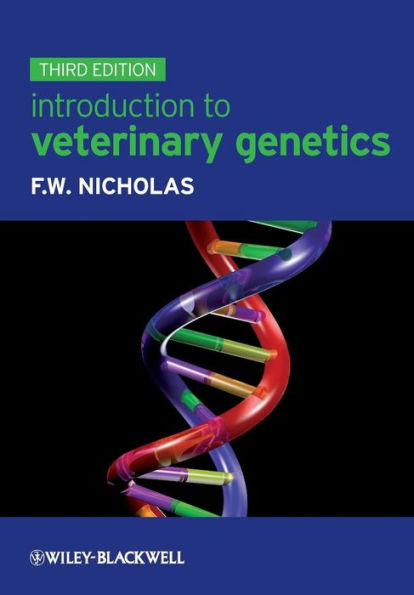Table of Contents
Preface x
1 Basic genetics 1
Chromosomes 1
Meiosis and mitosis 4
The biochemistry of inheritance 11
What is a gene? 18
Gene regulation 22
Mutation 23
Genes, alleles, and loci 24
Simple or Mendelian inheritance 25
Linkage 27
Inactivation 32
Types of DNA 35
Further reading 38
Appendix 1.1 Banded karyotypes of domestic species 39
2 Molecular biology 46
Restriction enzymes 46
Recombinant DNA and DNA cloning 49
Complementary DNA 51
DNA sequencing 53
Polymerase chain reaction 55
Southern analysis and related technologies 58
DNA expression microarrays 58
The detection of variation in base sequence 60
Veterinary diagnosis 63
Variable number of tandem repeats (VNTR), DNA fingerprints, and microsatellites 64
Single nucleotide polymorphisms (SNPs) 68
Copy number variation (CNV) 69
Gene mapping 70
Whole-genome sequence assembly 74
Production of polypeptide from cloned DNA 76
Transgenesis 77
Antisense technology 80
RNA interference 81
Further reading 84
3 Single-gene disorders 85
Inborn errors of metabolism 85
Sex-limited inheritance 87
Genetic heterogeneity of disease 88
Type of gene action and type of disease 90
Phenocopies 91
A sample of single-gene disorders 92
A revolution in mapping and identifying the causal mutation of single-gene disorders 96
Further reading 98
Appendix 3.1 A sample of single-gene traits that have been characterized at the molecular level 98
4 Chromosomal aberrations 103
Abnormal chromosome number 103
Abnormal chromosome structure 107
Chromosomal aberrations in cancer 112
Evolution of karyotypes 113
Interspecific hybridization 113
Freemartins 114
Biological basis of sex 115
Classification of intersex 116
A sample of chromosomal aberrations 117
Further reading 119
Appendix 4.1 A sample of chromosomal aberrations in animals 119
5 Single genes in populations 121
Gene and genotype frequencies 121
Random mating 122
The Hardy–Weinberg law 123
Extensions to the Hardy–Weinberg law 125
Selection and mutation 127
Genetic drift and the founder effect 133
Extending population genetics to more than one locus 134
Further reading 137
6 Familial disorders not due to a single gene 139
Liability and threshold 139
The multifactorial model 139
More than one threshold 141
Some final points 143
Further reading 149
7 Is it inherited? 150
General evidence for a genetic aetiology 150
The four types of simple, Mendelian inheritance 151
Studying and analysing the data 153
Further reading 157
8 Immunogenetics 158
Antibodies 159
Red-cell antigens 160
The major histocompatibility complex (MHC) 163
Further reading 171
9 Pharmacogenetics 172
Genetic polymorphisms affecting drug metabolism 172
Genetics and anaesthesia 173
Warfarin resistance 174
Multifactorial pharmacogenetics 175
Further reading 178
10 Hosts, parasites, and pathogens 179
Host–pathogen interactions 179
Resistance in hosts 183
Resistance in parasites and pathogens 184
Control of parasites and pathogens 188
Increasing the level of resistance in hosts 190
Further reading 193
11 Single genes in animal breeding 195
Coat colour 195
Examples of coat-colour genes 195
Carpet wool 200
Prolificacy in sheep 200
Polledness 201
Muscular hypertrophy in cattle and sheep 201
Dwarf poultry 202
Genes for sexing chickens 202
Pedigree checking 204
Further reading 206
12 Relationship and inbreeding 207
The inbreeding coefficient 207
Relationship 208
The inbreeding coefficient revisited 209
A general expression for relationship and inbreeding 210
The base population 211
Inbreeding in populations 212
Inbreeding depression 212
Further reading 215
13 Quantitative variation 216
Quantitative traits 216
The performance of an individual animal 218
The differences between animals 220
Heritability 221
Correlations between traits 224
Quantitative trait loci (QTL) 224
Further reading 228
14 Selection between populations 230
Comparison between populations 230
Genotype–environment interaction 232
Further reading 234
15 Selection within populations 235
Estimated breeding values and accuracy of selection 235
Clues to a candidate’s breeding value for a trait 236
Combining clues from more than one source 236
Best linear unbiased prediction (BLUP) 238
Correlated traits 239
Selection for more than one trait 240
The importance of inbreeding and genetic drift 242
Sire-reference schemes 243
Marker-assisted selection (MAS) and genome-wide selection (GWS) 244
Further reading 247
16 Breed structure 249
The traditional pyramid 249
Closed-nucleus breeding schemes 249
Open-nucleus breeding schemes 250
Information nucleus 252
Further reading 253
17 Crossing 254
Regular crossing 254
Crossing to produce a synthetic 260
Grading-up 261
Further reading 265
18 Selection and regular crossing 267
Selection 267
Selection and regular crossing 267
Further reading 269
19 Biotechnology and the future 270
Artificial insemination (AI) 270
Multiple ovulation and embryo transfer (MOET) 271
In vitro maturation (IVM) and in vitro fertilization (IVF) of ova 272
Control of sex ratio 273
Recombinant proteins 273
Transgenesis 274
Animal cloning 275
Further reading 279
20 Conservation genetics 280
Measurement of genetic diversity within populations 280
Measurement of genetic diversity among populations 282
Importance of genetic diversity 283
Loss of genetic diversity 284
Conservation of genetic diversity 286
Further reading 289
21 Genetic and environmental control of inherited disorders 291
Environmental control of inherited disorders 291
Genetic control of single-gene disorders 294
Gene therapy 300
Genetic control of multifactorial disorders 300
Genetic control – some final points 302
Crossing: thinking outside the square 304
Further reading 306
Glossary 307
Index 310



